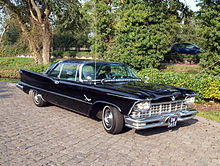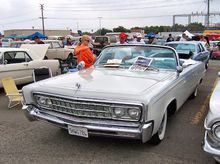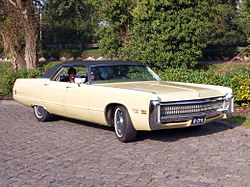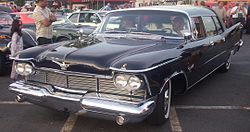- Imperial (automobile)
-
- For Chrysler branded models before 1955 and after 1983 see Chrysler Imperial.
- This article is about the Imperial marque manufactured by U.S. auto maker Chrysler. For the marque used by British manufacturers in the early 20th century, see Imperial (British automobile).
Imperial 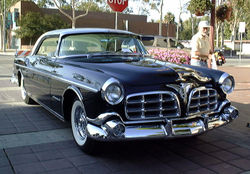
1955 Imperial NewportManufacturer Chrysler Production 1955-1975
1981-83Class luxury car Layout FR layout 
Imperial was the Chrysler Corporation's luxury automobile brand between 1955 and 1975, with a brief reappearance in 1981 to 1983.
The Imperial name had been used since 1926, but was never a separate make, just the top-of-the-line Chrysler. In 1955, the company decided to spin it off as its own make and division to better compete with its rivals, Lincoln and Cadillac. Imperial would see new body styles introduced every two to three years, all with V8 engines and automatic transmissions, as well as technologies that would filter down to Chrysler corporation's other models.
1955: A separate make
First generation 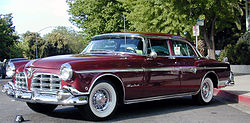
1955 ImperialModel years 1955-1956 Assembly Detroit, Michigan, USA Body style 2-door Newport hardtop
4-door sedan
4-door Southampton hardtopEngine 331 cu in (5.4 L) Hemihead V8
354 cu in (5.8 L) Hemihead V8Transmission 2-speed PowerFlite
3-speed TorqueFlite A488Wheelbase 1955:130.0 in (3,302 mm)
1956:133.0 in (3,378 mm)Length 1955: 223.0 in (5,664 mm)
1956: 229.6 in (5,832 mm)Width 1955: 79.1 in (2,009 mm)
1956: 78.8 in (2,002 mm)Height 1955: 61.2 in (1,554 mm)
1956: 61.5 in (1,562 mm)Curb weight 4,700–4,900 lb (2,100–2,200 kg) Designer Virgil Exner For the 1955 model year, the Imperial was launched and registered as a separate marque, apart from the Chrysler brand. It was a product of the new Imperial Division of Chrysler Corporation, meaning that the Imperial would be a make and division unto itself, and not bear the Chrysler name. Chrysler introduced Forward Look Styling by Virgil Exner, who would define Imperial's look (and the look of cars from the other four Chrysler divisions) from 1955 to 1963.
1955
The 1955 models are said to be inspired by Exner's own 1952 Chrysler Imperial Parade Phaeton show cars (which were themselves later rebodied to match the 1955-56 Imperials). The platform and bodyshell were shared with that year's big Chryslers, but the Imperial had a wheelbase that was 4.0 inches (102 mm) longer, providing it with more rear seat legroom, had a wide-spaced split eggcrate grille, the same as that used on the Chrysler 300 "executive hot rod", and had free-standing "gunsight" taillights mounted above the rear quarters, which were similar to those on the Exner's 1951 Chrysler K-310 concept car. Gunsight taillights were also known as "sparrow-strainer" taillights, named after the device used to keep birds out of jet-engines. Such taillights were separated from the fender and surrounded by a ring and became an Imperial fixture through 1962, although they would only be free-standing in 1955-56 and again in 1962. Models included a two-door Newport hardtop coupe (3,418 built) and a four-door sedan (7,840 built). The engine was Chrysler's first-generation Hemi V8 with a displacement of 331 cu in (5.4 L) and developing 250 brake horsepower (186 kW). Power brakes and power steering were standard. The only major option on the 1955 and 1956 Imperials was air conditioning, at a cost of $535. Production totaled 11,430, more than twice the 1954 figure, but far below Lincoln and Cadillac.
1956
The 1956 models were similar, but had small tailfins, a larger engine displacement of 354 cu in (5.8 L) with 280 brake horsepower (209 kW), and a four-door Southampton hardtop sedan was added to the range. 10,268 were produced. With a wheelbase of 133.0 inches (3,378 mm), longer than the previous year's by 3.0 inches (76 mm), they would have the longest wheelbase ever for an Imperial. This also contributed to an increase in their overall length to 229.6 inches (5,832 mm), making them the longest non-limousine post WWII American cars until the advent of the Imperials of the "Fuselage Look" era.
1957: A separate platform
Second generation
1957 Imperial Crown coupeModel years 1957-1966 Assembly Dearborn, Michigan, USA
Detroit, Michigan, USABody style 2-door hardtop
2-door convertible
4-door sedan
4-door hardtopPlatform D-body Engine 392 cu in (6.4 L) Hemihead V8
413 cu in (6.8 L) Wedgehead V8
440 cu in (7.2 L) Wedgehead V8Transmission 3-speed TorqueFlite A488
3-speed TorqueFlite A727Wheelbase 129.0 in (3,277 mm) Length 1957: 224.4 in (5,700 mm)
1958: 225.9 in (5,738 mm)
1959-60: 226.3 in (5,748 mm)
1961-62: 227.1 in (5,768 mm)
1963-66: 227.8 in (5,786 mm)Width 1957: 81.2 in (2,062 mm)
1958: 81.3 in (2,065 mm)
1959: 81.0 in (2,057 mm)
1960: 80.1 in (2,035 mm)
1961-63: 81.7 in (2,075 mm)
1964-66: 80.0 in (2,032 mm)Height 1957: 57.5 in (1,461 mm)
1958: 56.7 in (1,440 mm)
1959: 56.9 in (1,445 mm)
1960-61: 56.7 in (1,440 mm)
1962-64: 56.8 in (1,443 mm)
1965: 57.2 in (1,453 mm)
1966: 55.8 in (1,417 mm)Curb weight 4,800–5,500 lb (2,200–2,500 kg) Designer Virgil Exner and Elwood Engel For the 1957 model year, the Imperial received its own platform, setting it apart from any other division of Chrysler. This would last through the 1966 model year. Imperials during this period were substantially wider, both inside and out, than other Mopars with front and rear shoulder room equal to 64.0 in (1,626 mm) and 62.0 in (1,575 mm) respectively. The front seat shoulder room measurement remains an unsurpassed record for Imperial and would remain the record for any car until the 1971-1976 GM full-size models. Exterior width reached a maximum of 81.7 in (2,075 mm) during 1961-1963, which remains the record for the widest American car. After Lincoln downsized in 1961 this generation of Imperial had no real competitor for the title of largest car for the remainder of its decade-long lifespan.
One advantage of Imperials of this vintage was their strength; their crashworthiness got them banned from most demolition derbies for being too durable. Unlike the rest of the Chrysler Corporation makes (Plymouth, De Soto, Chrysler, and Dodge), that began unibody construction in 1960, the Imperial retained separate full perimeter frames for rigidity through the 1966 model year. These substantial frames had a box cross section with crossmembers forming an "X". The drive shaft passed through a hole in the "X" frame. The emergency brake gripped the drive shaft, and was not connected to the rear drum brakes prior to 1963.
Another advantage was that Imperial, and all Mopars, received "Torsion-Aire" suspension in 1957. Torsion-Aire was an indirect-acting, torsion-bar front suspension system which reduced unsprung weight and shifted the car's center of gravity downward and rearward. Torsion-bar suspension on the front combined with multi-leaf springs on the rear provided a smoother ride and improved handling. Tom McCahill, an automobile critic with a reputation for colorful metaphors, quipped that Imperial "cornered at speed flatter than a tournament billiard table", unusual for a car of its prodigious weight and extreme dimensions. McCahill became a loyal customer, buying a new Imperial yearly 1957 through 1962. His visible and enthusiastic endorsement helped Imperial forge a reputation as the "driver's car" among the big three luxury makes.
Forward Look
1957
The 1957 model year was based to an even greater degree on Virgil Exner's "Forward Look" styling (also used on other full-size Chryslers of the period). It featured a complicated front end (similar to Cadillacs of the period) with a bulleted grille and quad headlights, tall tailfins, and Imperial's trademark gunsight taillights. For the first time on an American car curved side glass was used. The Hemi engine was available for the first two years that was enlarged to 392 cu in (6.4 L). Power seats and dual exhaust were made standard across the line. A convertible was available for the first time on an Imperial and available in the mid-range Crown series. Sales were helped by Exner's "ahead of the competition" styling, with 1957 becoming the best-selling Imperial year ever. 37,593 were produced, but Cadillac by contrast sold over 120,000 cars in 1957. Quality control also slipped considerably, a consequence of the second total redesign in two years.
Starting from 1957, Imperials were available in three levels of trim: standard Imperial (also known as Imperial Custom), Imperial Crown, and the new, super-luxury Imperial LeBaron (not to be confused with the later, cheaper Chrysler Le Baron). Through the late 1950s and into the early 1960s styling would continue to become "Longer, Lower, Wider", with the addition of some of the wildest fins on a car. The "FliteSweep Deck Lid", a fake continental tire bulge, was an option from 1957 through 1961 and again in 1963 (due to demand). It was shared with contemporary Mopars, including the Valiant. Exner's love of this feature extended back to early-fifties concept cars like the 1953 Chrysler D'Elegance.
1958
Styling changes in 1958 were limited to the front grille and bumper. Quad headlights became standard. The 1958 Imperial is credited with the introduction of cruise control, which was called "Auto-Pilot", and was available on the Imperial, and on Chrysler New Yorker and Windsor models.[1] Power door locks were another new option. Sales slipped to 16,133 in a recession year. Dealers were frustrated with buyers referring to the cars as a "Chrysler Imperial", which inhibited sales as Chrysler was not seen as having Cadillac or Lincoln's prestige. It didn't help that Imperial continued to be sold at Chrysler dealerships, instead of stand-alone dealers, although it did have a separate "Imperial" dealership sign.
1959
Production was moved from the Jefferson Avenue assembly plant in Dearborn to an exclusive facility on Warren Avenue in Detroit. Other than a toothy new grill and revisions to side trim little changed in terms of exterior styling for the 1959 model year. A new option was the "Silvercrest" roof which featured a stainless steel front with a rear canopy that could be ordered either in any of the basic car colors or in the "Landau" version which had a black canopy with the appearance of leather. Another new option was swivel out front seats that were part of the six way electric front bench seat. Manually-activated by a handle for this introductory year, for 1960 and 1961 the seats would automatically swivel when the front door was opened activated by a cable. The Hemihead engine was replaced with the less expensive 413 cu in (6.8 L) Wedgehead engine that nevertheless had more horsepower and weighed 101 lbs less, improving the power-to-weight ratio. 17,710 Imperials were produced for the model year, ahead of Lincoln.
Exner's last Imperials
While many critics of automobile styling rate the 1955 through 1959 Imperials highly,[citation needed] the design of the 1960-1963 period is more controversial. At that time, Exner was increasingly struggling with the Chrysler president and board. "It was during 1962 Exner was dethroned as president of design in Highland Park. His successor was Elwood Engel, lured away from Ford to lead Chrysler Corporation along a more conventional path. Exner continued as a consultant through 1964, after which he had no further involvement."[citation needed] This source[which?] also states, "When he was good, he was very good ( re: styling). When he was bad.... it was the epitome of excessive design. Sales dropped off and the board stepped in."[citation needed] Exner's son went on further, in a 1976 interview, "it was time for a change. Their image needed changing. Dad was a great designer and he was always ahead of his time. He gained more freedom from Chrysler in his designs of the modern Stutz."[citation needed] This same source[which?] gives blow-by-blow accounts how Chrysler Corporation was revived through corporate changes in leadership. "But on the product front, the influence of Tex Colbert (ousted President of Chrysler in 1961) and Virgil Exner was still present, and it wouldn't be entirely washed away until 1965". < [2]
Despite the annual styling changes, all 1960-63 models featured a similar space age dashboard. The steering wheel was squared-off at top and bottom, designed for better leg room and view through the windshield in the straight ahead position. Dashboard lighting was electroluminescent, which used no light bulbs: electricity running through a five-layer laminate caused the phosphorescent paint to glow in the dark. Chrysler called it "Panelescent", and it was shared on some Chrysler models. The effect was eerie and surprisingly modern, with its glowing green face and bright red needles. The 1960-63 models were also united by a distinctive side trim that started above the headlights and that ran at a slight downward angle almost to the end of the rear fender (except in 1963 when it would actually wrap all the way around the rear of the car) that was undercut by a slight indent in the sides from the front until just before the rear wheel housing.
More importantly, but perhaps less obviously, a significant change in the car's proportions had occurred between the 1959 and 1960 model years. Although, at 226.3 inches, the 1960 Imperials were exactly the same length as the previous year, the whole body had been shifted forward, with a 2.1 inch reduction in the rear overhang, and a corresponding increase at the front. This led to a look that, due to a relatively smaller rear deck and more expansive front hood, was closer to Exner's classic car era ideals, and it would persist, by one means or another, for the remainder of Imperial's existence as a separate marque.
1960
The 1960 Imperial adopted wildly exaggerated styling, featuring front fascia with a swooping bumper, gaping mesh grille, giant chrome eagle, and hooded quad headlights, and tall rear fins. Soaring fins had bullet style tail lamps at the peak of the fin, with a chrome ring surrounding it. The grille and bumper on the front of the 1960 used large pieces of heavy chrome, and the 'furrowed brows' of the fenders over the double sets of headlights gave the car a ponderous look. In common with most other 1960 Chrysler products, the Imperial featured the new "High-Tower" seat with the driver-side back individually contoured and raised above of the rest of the front seat for increased driver comfort and shoulder support. This would last through the 1962 model year. Also in 1960, Imperial changed back to 15 inch diameter wheels from the 14 inch diameter wheels that had been standard since 1957. Imperial LeBarons now featured a distinctive smaller "formal rear window" for greater rear seat privacy. Sales increased to 17,719. Imperial again finished ahead of Lincoln, but never did so again. While the rest of Chrysler's lineup adopted unibody construction, Imperial retained its body on frame construction.
1961
The 1961 model year brought a wholly new front end with free-standing headlights on short stalks in cut-away front fenders (a classical throwback favored by Virgil Exner. He would continue his look with the modern Stutz), and the largest tailfins ever. Inside, the Imperial gained an improved dash layout with an upright rectangular bank of gauges. The pillared four-door sedan was cancelled and would not return until the 1967 model year. With the downsizing of Lincoln, at 227.1 inches (later increased to 227.8 inches in 1963), the Imperial would once again be the longest non-limousine car made in America though 1966. Sales fell to 12,258, the result of bizarre styling and continued poor quality control.
1962
The tailfins were largely truncated in 1962, topped with free-standing gunsight taillights, but these were elongated, streamlined affairs. The front grille was split, as in 1955-56, and a large round Eagle hood ornament was fitted for the first time. The 1962 models had a new, slimmer TorqueFlite A727 transmission, which allowed for a smaller transmission "hump" in the floor. This provided greater comfort for passengers in the center seat up front. Dual exhaust was now only standard on convertibles. 1962 also marked the closing of Imperial's dedicated assembly plant. All later Imperials were once again built in the same Jefferson Avenue facilities in Detroit as Chryslers, as sales were insufficient to maintain a separate facility. 1962 production totaled 14,337. Shortly before leaving Chrysler, Virgil Exner had planned for a smaller Imperial to go along with the downsized 1962 Mopars, but the idea never went anywhere.
1963
The 1963 models saw the split grille disappear again, replaced by a cluster of chromed rectangles, and the taillights were now inside the rear fenders, in ordinary fashion, for the first time. In addition, the designers redesigned the rooflines of the two-door hardtops, giving them a similar appearance to the four-door models. 1963 models were the last Virgil Exner–styled Imperials, however Elwood Engel began applying some of his own touches to them. 14,121 cars were produced for 1963.
Engel's first Imperials
In 1961, Chrysler scored a coup by hiring Elwood Engel away from Ford, where he had designed the 1961 Lincoln Continental. Engel's design themes at Chrysler were a major departure from the fins of Virgil Exner, and instead featured a more familiar three-box design, but with more extreme rectilinear styling. And, at first glance, the total re-styling of the Imperial in 1964 was thought to strongly resemble Elwood Engel’s previous efforts for the 1961 Lincoln Continental. Both cars shared clean, slab-sided body panels, thick C-pillars, and a chrome molding outlining the top of the fender line. However, Engel used subtle curves and parallelogram angles to give the Imperial a distinct and novel look.
1964
The 1964 Imperials were the first designed entirely by Engel. Predictably, they bore a strong resemblance to the Lincoln Continental. The dashboards seemed more conventional because the squared-off steering wheel and electroluminescent dash lighting were gone. However, there remained the ribbon-style speedometer. A split grille returned after one year's absence, and the fake spare tire bulge atop the trunk lid gave way to a squared-off protrusion at the rear, carrying downward into the rear bumper. A large boss in the center of it was actually the fuel filler door, covered with a large Imperial Eagle, with chromed bars going outward that terminated in the taillights. Heat and defrost, always a popular option, were now standard.
The base Imperial Custom model was now gone; the cars were now available as a four door hardtop in the Crown or LeBaron levels of trim, or as a two-door hardtop or convertible in the Crown level of trim. As a result power windows were now standard on all Imperials. Imperial Crown coupes adopted the smaller style LeBaron "formal rear window" that had been introduced in 1960, and both body styles could now be ordered with a vinyl roof. With 23,295 produced, 1964 was Imperial's second best talley ever.
1965
Changes for 1965 were largely confined to the front fascia and to trim, and replacement of the push-button automatic transmission gear selection system with a more conventional steering column-mounted shift lever. The split grille was gone, replaced by a large chromed crossbar and surround, and the headlights were inset into the grill behind glass covers (similar to that year's Chrysler 300 and New Yorker models) with etched horizontal lines imitating the grill. As pointed out by the sales literature, 100-year-old Claro Walnut trim was added to the interior. Production totaled 18,409.
1966
This was the final year for the Imperial platform that was first created in 1957. All subsequent years through 1966 used this same basic platform with annual changes to the body sheetmetal. However, the Imperial still used the wrap-around windshield that had been dropped by most other makes for entry and exit room when they almost all simultaneously downsized in 1961.
The 1966 model year saw a change to an egg-crate grille. The glass headlight covers lost the etched lines but gained twin 24k gold bands around the perimeter. The trunk lid bulge became more squared off with a smaller Imperial script off to the side. The back-up lights were moved to the rear bumper. The Claro Walnut trim that had been introduced the previous year was used more extensively and would be replaced the following year. The 413 cu in (6.8 L) engine that had been standard since 1959 was replaced with a 350 hp (261 kW; 355 PS) 440 cu in (7.2 L) engine.[3]
Production totaled 13,752. There was a 1966 LeBaron that was presented to Pope Paul VI at the UN in New York for his use. Also this year, Imperial was the basis for the "The Black Beauty" a rolling arsenal on the ABC-TV series The Green Hornet, starring Van Williams and Bruce Lee. Strongly identified with the Green Hornet and Kato characters, an Imperial of this vintage was also used as the Black Beauty in the 2011 film of the same name.
Unibody is adopted
Third generation 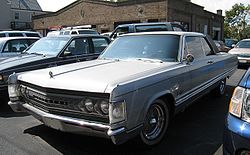
1967 Imperial Crown coupeModel years 1967-1968 Assembly Detroit, Michigan, USA Body style 2-door hardtop
2-door convertible
4-door sedan
4-door hardtopPlatform C-body Engine 440 cu in (7.2 L) Wedgehead V8[4] Transmission 3-speed TorqueFlite A727 Wheelbase 127 in (3,226 mm) Length 1967: 224.7 in (5,707 mm)
1968: 224.5 in (5,702 mm)Width 79.6 in (2,022 mm) Height 1967: 56.7 in (1,440 mm)
1968: 57.0 in (1,448 mm)Curb weight 4,900–5,200 lb (2,200–2,400 kg) Designer Elwood Engel With the exception of the introduction of a shorter wheelbase and unit body construction, Imperial styling was not radically changed for the 1967 and 1968 models. The new body maintained the themes established by Engel for the 1964-1966 models. Imperial switched from the body-on-frame platform (D-body) to a unibody platform (C-body platform used in other full size Mopars.) While Imperial's front K member was 3.0 inches (76 mm) longer than a Chrysler's, dimensions behind the front fenders were similar. One reason for the change was that Chrysler had gained experience with unibody construction and was ready to apply it to the company's flagship line. The economic component was that the switch to the C-body was less expensive than maintaining a separate platform for Imperial, which was increasingly difficult to justify given Imperial's relatively low sales volume. The new platform resulted in a significant reduction in weight as well as in exterior and interior dimensions.
1967
Imperial shared the unibody platform with other full-sized Chryslers but retained a unique bodyshell. The styling kept the overall straight-line, sharp-edged Engel theme, but there were many detail changes intended to make Imperial look less like Lincoln and more into its own territory. The spare tire bulge was completely gone from the rear, although the boss remained. The practically full-width taillights spread out from it, straight, but ended before chrome-tipped rear wings. The front end was somewhat similar to 1966's, although the glass lamp covers were gone. A base Imperial model, simply called Imperial, returned for the first time since 1963, complementing the Crown and LeBaron levels of trim. It contained the convertible, which had previously been a Crown, and the first four-door pillared Imperial sedan since 1960. Dual exhaust was no longer standard on the convertible. The only way to get it was to order the "TNT" version of the 440 engine, an option that promised more power.
An option on Crown coupes was the Mobile Director. [5]. Essentially the front passenger seat turned to face rearward and a small table and high intensity light folded out over the back seat. The idea was that an "executive" could turn around and do work while being driven to the office, or he could sit behind the driver and a secretary could take dictation in the rear-facing front seat. The concept originated with the 1966 Mobile Executive Show Car that was an Imperial Coupe fitted with a telephone, Dictaphone, writing table, typewriter, television, reading lamp and stereo. Chrysler also used the reversed front seat idea in the 300X show car. Costing $597.40 ($317.60 in 1968), at a time when a Crown coupe started at $6011, it was a very expensive option. Thus a total of only 81 Crown coupes were ordered this way, and only a handful so equipped are known to still exist. The option was cancelled at the end of the 1968 model year. Sales increased to 17,614.
1968
The 1968 Imperial was little changed from the previous year. The grille changed to a brightly chromed one with thin horizontal bars, split in the middle by vertical chrome and a round Imperial Eagle badge. At the rear, the horizontal bars over the taillights were gone. All 1968s came with a Federally mandated energy absorbing steering column.[4] The base level of trim was cancelled after only one year and the convertible and four-door sedan became part of the Crown level of trim. This was also the last year for the Imperial convertible. A total of 15,367 Imperials were sold in 1968.
Fuselage Look
Fourth generation
1972 Imperial LeBaronModel years 1969-1973 Assembly Detroit, Michigan, USA Body style 2-door hardtop
4-door sedan
4-door hardtopPlatform C-body Engine 440 cu in (7.2 L) Wedgehead V8 Transmission 3-speed TorqueFlite A727 Wheelbase 127.0 in (3,226 mm) Length 1969-71: 229.7 in (5,834 mm)
1972: 229.5 in (5,829 mm)
1973: 235.3 in (5,977 mm)Width 1969-71: 79.1 in (2,009 mm)
1972-73: 79.6 in (2,022 mm)Height 1969-70: 55.7 in (1,415 mm)
1971: 56.1 in (1,425 mm)
1972: 56.0 in (1,422 mm)
1973: 56.2 in (1,427 mm)Curb weight 4,900–5,200 lb (2,200–2,400 kg) Designer Elwood Engel The "Fuselage Look" was how Chrysler described its new styling in 1969. Instead of the square lines of 1964-68, the new Imperials featured rounded "tumblehome" sides, bulging at the belt line, and tucking in down to the rocker panels. The new styling not only made the cars look longer and wider, it also surrounded the passengers in a hull-like fashion, similar to an aircraft, hence the reference to "fuselage". The curved side glass, which had been pioneered in America by Imperial in 1957, had a much tighter radius, while the increased curvature of the bodysides permitted the window frames to be moved outboard at their bases, resulting in an increase in shoulder room without an increase in overall body width compared to the previous C-body. In fact, front and rear shoulder room increased from 59.4 in (1,509 mm) to 62.7 in (1,593 mm) on 4-door hardtops.
To reduce development and tooling costs, and bring overall expenditures more in line with actual sales, Imperial was forced to share much of its bodyshell with Chrysler for the first time since 1956. Consequently, front and rear doors, quarter panels, decklids, glass, and roofs were common with the lowliest Chrysler Newport. In other respects, however, little had changed; construction was still unibody, the wheelbase was still stretched 3.0 in (76 mm) longer than a Chrysler's in front of the passenger section, the engine and transmission were the same, and the torsion bar front suspension was still used.
1969
In keeping with the times, the look was sleeker, with a reduced, more subtle level of trim. For the first time, the lights were hidden behind doors, giving a fashionable at the time full-width grille look using "loop" bumpers. Only this year the Imperial featured sequential turn signals. 1969 was the final year for pillared sedans, and it was also the first year for the Imperial LeBaron coupe. At 229.7 inches Imperial would once again be the longest non-limousine car made in America, and would remain so through 1973 when it would set the post WW II record for non-limousine car length. 22,083 were produced for Imperial's third best ever year.
1970
The 1970 models differed only in minor ways. The grill pattern changed to a larger eggcrate design; the front cornering lamps were now rectangular instead of the "shark gill" pattern of 1969. A wide chrome strip was added at the rocker panels, vinyl side trim was made optional, and (for this year only) the fender skirts were gone. It was the final year for the Crown series; afterwards Imperial would have only two models, a LeBaron hardtop sedan and coupe. 11,822 of the 1970s were produced.
1971
For 1971, the Imperial Eagle at the front of the hood was gone, replaced by the word IMPERIAL; the deck lid badge said, for the first time, "IMPERIAL by Chrysler". The 1971 Imperial is notable for being the first production car in America with a 4-wheel Anti-lock braking system (ABS)[6] from Bendix, a rarely selected option at that time. The 1966 Jensen FF from England was the first production car in the world to have ABS. Both had ABS for almost a decade before the Mercedes-Benz S-Class which claims to be the first production car with ABS1978. 11,569 1971 Imperials were produced.
Although the vinyl top was standard, for a short time a unique paisley-patterned vinyl top in a burgundy color was available as an option on burgundy-painted cars. It has been rumored that this top had actually been overprinted on waste "Mod Top" patterned vinyl, which had been available on some Dodge and Plymouth models in 1969 and 1970, but, according to Jeffrey Godshall, a Chrysler designer and frequent contributor to the magazine Collectible Automobile, this was not the case. With exposure to the elements, the burgundy overprint faded, and the pattern began to show through in a purple "paisley" pattern.[7] Chrysler replaced many affected tops with either white or black standard vinyl, but some survive.
Fuselage evolution
1972
The sheetmetal was completely new for the 1972 model year, although the styling was an evolution of the previous fuselage style, somewhat more rounded in side profile, without a character line down the side and chrome trim on the top seams of the fenders from the rear windows forward. The front fascia was all new and imposing-looking, and the back featured vertical teardrop taillights for the first time, while the rear side marker lights were in the form of shields with eagles on them. Sales increased to 15,796
1973
The 1973 model year saw new federal bumper standards to prevent damage. This meant the Imperials gained large rubber over-riders front and rear, adding 5.8 inches (147 mm) to the car's length, making it the longest production car in North America for that year and the longest postwar (non-limousine) production car at 235.3 inches (5,977 mm). As 1973 was in general a good year for the auto industry, 16,729 1973 Imperials were sold.
Final full-size
Fifth generation 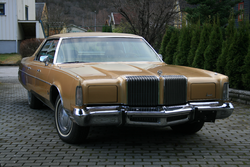
1975 Imperial LeBaronModel years 1974-1975 Assembly Detroit, Michigan, USA Body style 2-door Crown coupe
2-door hardtop
4-door hardtopPlatform C-body Engine 440 cu in (7.2 L) Wedgehead V8 Transmission 3-speed TorqueFlite A727 Wheelbase 124.0 in (3,150 mm) Length 1974: 231.1 in (5,870 mm)
1975: 232.7 in (5,911 mm)Width 79.7 in (2,024 mm) Height 1974: 54.7 in (1,389 mm)
1975: 54.5 in (1,384 mm)Curb weight 5,000–5,200 lb (2,300–2,400 kg) Designer Elwood Engel On the eve of final plans for the 1974 model year things looked bleak for Imperial. The marque had lost its exclusive assembly plant in 1962. It had lost its unique platform in 1967. Then in 1969 it lost its unique bodyshell. Mention of the Chrysler name returned in 1971 after Imperial having been a separate marque for years. The 1973 model year appeared to be the end of the road for Imperial.
Chrysler had planned on quietly discontinuing the Imperial at the end of the 1973 model year. Without its own unique bodyshell, it would be difficult to compete with Cadillac and Lincoln, which had their own unique bodyshells. Sales were likely to remain low, as image and appearance were an important part of luxury car appeal. And, in turn, without sales, it seemed there was no way Chrysler could afford to build an Imperial with a unique appearance.
A front end design, which had been envisioned for the next Imperial by Chrysler/Imperial exterior studio senior stylist Chet Limbaugh, came to the attention of Elwood Engel. Engel showed the design to Chrysler president John Riccardo and convinced him to use it on an Imperial. Except for the front end clip and trunk lid, to save money it would use all the same body panels as the Chrysler New Yorker, and, for the first time in its history as a separate marque, it would have the same wheelbase. But the car would have Limbaugh's unique new "waterfall" grille design which featured thin vertical chrome bars, separated by a body-colored band running through the center, and which started on top of the nose and flowed down.
1974
With the full effects of the 1973 oil crisis being solidly felt, a bad year for the U.S. economy (and the auto industry as well) was in place for 1974. This was Chrysler's 50th anniversary year and the final redesign of the full-size Imperial. The 1974 Imperial was the first regular American passenger car to offer 4-wheel disc brakes since the 1949-1952 Crosleys, the 1949-1954 Chrysler Imperials, and the Chevrolet Corvettes that starting featuring them in 1965. The Imperial's ignition system was electronic, another first in the market, as was the optional burglar alarm. In addition to the two regular 1974 LeBaron models, a 50th Anniversary 2-door LeBaron Crown Coupe was also produced, finished in Golden Fawn; only 57 were built, making for a grand total of 14,483 Imperials produced for the model year.
1975
For 1975, other than an enhancement to the waterfall grille, the front bumper and a few detail improvements, little changed. This was to be the last year of the independent Imperial marque, with only 8,830 1975 models sold. The last Imperial, a LeBaron sedan, rolled out of the factory on June 12, 1975. However only the name disappeared, as the same basic car was offered, rather more cheaply (the Imperial feature of 4-wheel disc brakes was discontinued). From 1976 through 1978 the car was known as the Chrysler New Yorker Brougham. Justifying the price differential over the full-size Chrysler had become increasingly hard to do as the cars became more and more similar over the years to save costs, and in turn the costs of maintaining and marketing a separate, poorly selling marque were possibly just too high. Also, the 1973 oil embargo had turned buyers towards smaller more fuel efficient cars, a movement that had been building through the early-1970s as a result of rising fuel prices.
1981–1983
Sixth generation 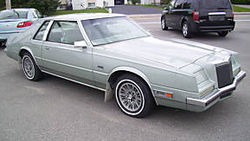
1981 ImperialModel years 1981–1983 Assembly Windsor, Ontario, Canada Predecessor Chrysler Newport Body style 2-door coupé Platform Y-body Engine 318 cu in (5.2 L) LA V8 Transmission 3-speed A904 automatic Wheelbase 112.7 in (2,863 mm)[8] Length 213.3 in (5,418 mm) Width 72.7 in (1,847 mm) Height 52.6 in (1,336 mm) Curb weight 3,968 lb (1,800 kg) Related Dodge Mirada
Chrysler CordobaThe 1981-83 Imperial was an attempt to reinvent the Imperial as a personal luxury car. This came about after Lee Iacocca took the helm at Chrysler, since he had been instrumental in creating the successful Lincoln Mark series for this market while he was at Ford in the late 1960s. Although the company was facing bankruptcy, Iacocca decided that "a new flagship would assure the public that Chrysler had a future."[9] During the design of the car it was intended to be named Chrysler LaScala.[10] However, when the car finally appeared, it was marketed simply as an Imperial, and the Chrysler name was not used.[1]
The new Imperial was a smaller, two-door only package, sharing its wheelbase chassis with the second generation Chrysler Cordoba and Dodge Mirada. Neither a convertible nor a 4-door version was available, though conversions were made of both by 3rd party companies. The Cordoba and Mirada models were designated the J-bodies, while the Imperial was a Y-body.
The Imperial was equipped as standard in: power windows, seats, Electronic VFD dash (including odometer, speedometer, gear selection, gas calculations, and clock), electronic door lock, garage opener, air conditioning, electric adjustable seats, and other convenience features. Because of rich standard equipment list there were virtually no options, other than a cost-free choice of wheels (color coded 'snowflakes' could be deleted in favor of steel with 'wire wheel' hubcaps), upholstery choice (standard leather could be changed for cloth), sound systems choice, automatic speed control, 40-band CB radio,[11] and a power moonroof (1981 only).[12]
The Imperial eagle logo was not used as it had been moved to the Chrysler LeBaron model in 1977. Instead it bore a Chrysler Pentastar hood ornament made of Cartier crystal.
Competing models such as the Cadillac Eldorado and the Lincoln Continental Mark VI had been downsized by 1981, so the Imperial was of comparable size to its competitors, and the Eldorado was at that time rising to the peak of its success. A marketing effort for the new model included commercials and magazine ads featuring singer Frank Sinatra, a personal friend of Iacocca. Sinatra even recorded special songs to promote the new Imperial.[13]
The car did not fulfill Chrysler management's sales expectations. It had innovations like the fuel injection system and electronic instrument cluster, and Chrysler tried to use it as a showcase for technology and quality.[14][15] Unfortunately the fuel injection system proved troublesome and many cars were retrofitted under warranty (or later on owner initiative) with carburetors.[12][16]
NASCAR
A few race teams built and raced Imperials (without any factory support) on the NASCAR circuit from 1981 through the 1985 season, though mostly only on the superspeedways. They were driven by Buddy Arrington, Rick Baldwin, Cecil Gordon, Phil Goode, and Maurice Randall. The cars did not distinguish themselves to any great degree, however a Buddy Arrington owned and driven Imperial finished in sixth place in the summer 1982 race at Brooklyn, Michigan. The Imperial-based cars were used in competition as it was determined to be far more aerodynamic (and capable of higher speeds) than the Dodge Mirada at the time - it had drag coefficient of 0.41, which was better than contemporary Corvette (0.45),[17] and performed well on the big high speed tracks, with Morgan Shephard (driving Buddy Arrington's Imperial) qualifying for the 1985 Daytona 500 at a speed of 197 mph, despite the lack of suitable high performance race engines. One of Arrington's Imperials resides in the Talladega, Alabama NASCAR museum.[18]
Powertrain
The 318 cu in (5.2 L) V8, with a Chrysler-built throttle-body EFI system, was the only available engine. The automatic transmission was a wide-ratio TorqueFlite equipped with lock-up torque converter,[19] with the final drive ratio 2.2:1 in 1981 and 1983; 2.4:1 in 1982.[20][21]
engine displacement, type,
fuel systemmax. motive power
at rpmmax. torque
at rpmtransmission 318 cu in (5,211 cc) LA V8
EFI140 bhp (104 kW; 142 PS)
@ 4,000245 lb·ft (332 N·m)
@ 2,0003-speed TorqueFlite A904 automatic [22] Special trims
Frank Sinatra Edition
The Imperial had an unusual distinction: a special edition named after a celebrity. The Imperial fs was a rare example of automotive history, as it was one of only a handful of regular production cars bearing a celebrity's name. This limited edition Imperial was available only in Glacier Blue Crystal paint - Chrysler advertising claimed it matched the color of Sinatra's eyes - and had special fs (lowercase) external badging, with a large glovebox placard proclaiming "Frank Sinatra Signature Edition". Inside, 16 cassette tapes of Sinatra titles were presented in a specially-made Mark Cross leather case. In the center console of the car there was also special tray for 8 cassettes.[23][24] 271 fs edition cars were manufactured.[12]
Aside from the fs edition available for purchase by the public, Chrysler president Lee Iacocca commissioned a 1982 Imperial converted into a limousine with a 36 in (910 mm) stretch, and presented it to Frank Sinatra as a gift.[25]
Mark Cross Edition
Another trim was the Mark Cross edition. It consisted of leather seats plus other gadgets like umbrella, pendant and leather folio for the car's documents.[26]
Production figures and yearly changes
In 1982, 'floating cushion' front seats were replaced with seats of one-piece construction, and the power moonroof option was deleted. In 1983 the hood ornament was changed from Cartier crystal to plastic.[27]
Production figures[28] calendar year units 1980* 6,241 1981 3,466 1982 1,746 1983 932 total production = 12,385 *Cars manufactured in 1980 calendar year were sold as 1981 model year.
Crown Imperial (1955-1965 limousines)
Crown Imperial
1958 Crown ImperialModel years 1955-1965 Body style 4-door limousine Platform D-body (1957-1965) Engine 331 cu in (5.4 L) Hemihead V8
354 cu in (5.8 L) Hemihead V8
392 cu in (6.4 L) Hemihead V8
413 cu in (6.8 L) Wedgehead V8Transmission 2-speed PowerFlite
3-speed TorqueFlite A488
3-speed TorqueFlite A727Wheelbase 149.5 in (3,797 mm) Length 1955: 242.5 in (6,160 mm)
1956: 246.1 in (6,251 mm)
1957: 244.9 in (6,220 mm)
1958: 246.4 in (6,259 mm)
1959-60: 246.8 in (6,269 mm)
1961-62: 247.6 in (6,289 mm)
1963-65: 248.3 in (6,307 mm)Width 1955: 79.1 in (2,009 mm)
1956: 78.8 in (2,002 mm)
1957: 81.2 in (2,062 mm)
1958: 81.3 in (2,065 mm)
1959: 81.0 in (2,057 mm)
1960: 80.1 in (2,035 mm)
1961-63: 81.7 in (2,075 mm)
1964-65: 80.0 in (2,032 mm)Height 1955-56: 62.5 in (1,588 mm)
1957-65: 58.5 in (1,486 mm)Curb weight 5,300–6,300 lb (2,400–2,900 kg) Designer Virgil Exner and Elwood Engel During 1955 and 1956, a Crown Imperial limousine model was also offered. With an extra 19.5 in (500 mm) and 16.5 in (420 mm) of wheelbase in 1955 and 1956 respectively, and seating eight (three in the front including the driver, three in the rear, and two on rearward-facing fold-down jump seats), these replaced the long-wheelbase offerings in all Chrysler marques. Only 172 were built in 1955 and 226 in 1956. They were the last Chrysler-branded limousines built entirely in Detroit.
From 1957 until 1965, long-wheelbase Crown Imperial cars would be finished by Ghia in Italy. The earlier models used two-door hardtop bodies mounted on the more rigid convertible chassis; these would be shipped across the Atlantic, cut apart, lengthened by 20.5 inches (521 mm) and reworked. Later models were built from four-door models to the same specification. Each took a month to build and carried a high price for the time. They sold poorly against similar Cadillacs that were cheaper, had an established reputation among limousine buyers, and were built by Cadillac itself as well as a by competing coachbuilders on a Cadillac commercial chassis. A total of 132 Crown Imperials were manufactured for Chrysler by Ghia over 1957-65. An interesting oddity is that all 10 Ghia built Crown Imperials sold during the 1965 model year were 1964's with 1965 exterior styling, and consequently had pushbutton gearshifts. At about 6,200–6,300 lb (2,800–2,900 kg) curb weight the 1957-65 Ghia built Crown Imperials are the heaviest standard production cars sold by an American firm since the 1930s.
In President John F. Kennedy's funeral procession in November 1963, at the front of the motorcade, carrying Jackie Kennedy and her children, was a Ghia built 1960 Crown Imperial.
In the 1974 movie "The Godfather II", a black 1958 Imperial Ghia Limosine was used by Michael Corleone (played Al Pacino) while at the family compound near Reno Nevada (photos are found at http://www.imperialclub.com/Movies/Godfather/index.htm)
Post Ghia Imperial limousines (1966-1983)
While the "Crown Imperial" limousines ended in 1965, Imperial limousines continued to be made by other coach builders. After the last ten Ghia built Crown Imperials were completed, Ghia sold its tooling to Barreiros Coachbuilders of Spain. Barreiros built ten limousines, much like those built by Ghia and, similar to the last ten built by Ghia, built 1965's with 1966 exterior styling.
Between 1967 and 1971 a total of 27 Imperial limousines were produced by Stageway Coachbuilders (ASC) of Fort Smith, Arkansas on an 163.0 in (4,140 mm) wheelbase, and were justifiably advertised as the largest luxury automobiles in the world. Two 1972 models with 1973 grills were built by the Hess and Eisenhardt Company of Fairfield, Indiana for the United States Secret Service and were used by Presidents Nixon, Ford, Carter, and Reagan on his swearing-in day. One 1974 model Imperial was produced into a limo also by ASC. The final Imperial limo's were of 1981-83 bodied cars, two of which were stretched 24-inch (610 mm) and five were lengthened 36-inch (910 mm).
Imperial slogans
- "America's Most Carefully Built Car"
- "The Finest Car America Has Yet Produced"
- "Finest Product of Chrysler Corporation"
- "The Incomparable Imperial"
- "It's Time for Imperial" (1981–1983)
See also
References
- ^ Auto Editors of Consumer Guide (2007-10-08). "1958 Imperial Auto-Pilot cruise control". Auto.howstuffworks.com. http://auto.howstuffworks.com/1957-1959-imperial9.htm. Retrieved 2010-10-24.
- ^ Langworth, Richard (1985). The Complete History of Chrysler Corporation 1924-1985. Beekman House. p. 190. ISBN 0-517-44813-0.
- ^ Letourneau, P. A. (1994). Imperial 1964-1968. Minneapolis: Iconografix. p. 8. ISBN 1882256239.
- ^ a b Gunnell, John A., ed. Standard Catalog of American Cars 1946-1975. krause publications. ISBN 0-87341-027-0.
- ^ 1967 Imperial promotional brochure issued by manufacturer
- ^ "Directory Index: Chrysler_and_Imperial/1972 Chrysler/1972_Imperial_Press_Kit". Oldcarbrochures.com. http://www.oldcarbrochures.com/static/NA/Chrysler_and_Imperial/1972%20Chrysler/1972_Imperial_Press_Kit/1972%20Imperial%20Press%20Kit-04.html. Retrieved 2011-11-20.
- ^ "Rare Burgundy "Un-Paisley" Vinyl Roof Treatmentfor the 1971 Imperial LeBaron". imperialclub.com. 2004-05-03. http://www.imperialclub.com/Yr/1971/Paisley/. Retrieved 2011-08-28.
- ^ "Imperial Colors, Specifications and Dimensions". p. 22. http://www.imperialclub.com/Yr/1981/Brochure/Page22.jpg. Retrieved 2010-10-24.
- ^ Auto Editors of Consumer Guide (2007-06-14). "How Imperial Cars Work: Imperial's Brief Return". HowStuffWorks.com. http://auto.howstuffworks.com/imperial-cars4.htm. Retrieved 2010-10-24.
- ^ Dunne, Jim (June 1979). [Imperial (automobile) "Detroit Report"]. Popular Science - Google Books: 26. Imperial (automobile). Retrieved 2010-11-17.
- ^ 1982 Imperial promotional brochure issued by manufacturer
- ^ a b c "The 1981-83 Imperial". Allpar. 1978-10-05. http://www.allpar.com/cars/imperial/1981.html. Retrieved 2010-10-24.
- ^ "Advertisement: The Chairman of the Board tells "The Chairman of the Board" why it's time for Imperial". Chrysler Corporation. http://sinatrafamily.com/forum/attachment.php?attachmentid=7732&stc=1&d=1067830222. Retrieved 2010-10-24.
- ^ "Page from the official 1981 brochure, MarkCross4". Chrysler Corporation. http://www.imperialclub.com/YearByYear/1981/Literature/MarkCross/MarkCross4.jpg. Retrieved 2010-10-24.
- ^ "Page from the official 1981 brochure, 1Hmd". Chrysler Corporation. http://www.imperialclub.com/YearByYear/1981/Brochure/81brochure1Hmd.jpg. Retrieved 2010-10-24.
- ^ "It's time for Imperial (1981-83 Imperials)". Fourforty.com. http://www.fourforty.com/imperial/81-83.html. Retrieved 2010-10-24.
- ^ Popular Science - Google Books. Books.google.com. http://books.google.com/books?id=nRN263ekdaIC&lpg=PA69&dq=canon%20ae%201%20program%20popular%20science&pg=PA75#v=onepage&q&f=false. Retrieved 2011-01-06.
- ^ "Buddy Arrington's Winston Cup NASCAR 1981 Imperial". Imperialclub.com. 2005-07-07. http://www.imperialclub.com/Yr/1981/Buddy/index.htm. Retrieved 2010-10-24.
- ^ "Popular Science". April 1981. http://www.imperialclub.com/Articles/81PopSci/PS47-reg.jpg. Retrieved 2010-11-17.
- ^ "Official brochure with technical data". August 1982. p. 9. http://www.imperialclub.com/Yr/1983/Brochure/Page9Big.jpg. Retrieved 2010-10-24.
- ^ "Official 1982 brochure with axle ratio specified". August 1981. http://www.imperialclub.com/Yr/1982/Brochure/82bro12_md.jpg. Retrieved 2010-10-24.
- ^ "Carfolio specifications". Carfolio.com. http://www.carfolio.com/specifications/models/car/?car=43483. Retrieved 2010-10-24.
- ^ "Tapes Included with 1981 and 1982 (Chrysler) Imperial Frank Sinatra Edition". Imperialclub.com. 2004-06-17. http://www.imperialclub.com/YearByYear/1982/SinatraTapes.htm. Retrieved 2010-10-24.
- ^ "1981 Flyer". Imperialclub.com. http://www.imperialclub.com/YearByYear/1981/1981FS/index.htm. Retrieved 2010-10-24.
- ^ "1981, 1982, and 1983 (Chrysler) Imperial Limousine Discussion". Imperialclub.com. 2006-02-19. http://www.imperialclub.com/Yr/1981/Limo/index.htm. Retrieved 2011-11-20.
- ^ "Page from the official 1981 brochure, MarkCross3". Chrysler Corporation. http://www.imperialclub.com/YearByYear/1981/Literature/MarkCross/MarkCross3.jpg. Retrieved 2010-10-24.
- ^ "Known changes in the production run of the 1981-83 Imperial automobiles". mperialclub.com. p. 1. http://www.imperialclub.com/YearByYear/1981/81-83-Changes/Page01-reg.jpg. Retrieved 2010-10-24.
- ^ "1981-1983 Chrylser Imperial Month by Month Production Figures". imperialclub.com. http://www.imperialclub.com/YearByYear/1981/81-83-Changes/Page06-reg.jpg. Retrieved 2010-10-24.
External links
- Online Imperial Club
- Fuselage bodies at Allpar.com
- J-bodies at Allpar.com
- 1969 - 1973 Imperials at Fuselage.de site
- Imperials listed by model and chassis in movies and TV series
Chrysler Marques CurrentDefunctAMC (1966–1988) · Commer (1905–1979) · Barreiros (1959–1978) · DeSoto (1928–1961) · Eagle (1988–1998) · Fargo (1920–1972) · Hillman (1907–1976) · Humber (1898–1975) · Imperial (1955–1975, 1981–1983) · Karrier (1908–1977) · Plymouth (1928–2001) · Singer (1905–1970) · Simca (1934–1977) · Sunbeam (1901–1976) · Valiant (1960–1966)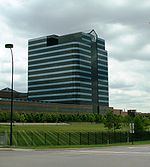
Divisions and
subsidiariesCurrentChrysler Australia · Chrysler Canada · Dodge · Jeep · Mopar · Ram Trucks · Street and Racing Technology (SRT) · Road Track (R/T)DefunctAmerican Motors Corporation (1954–1988) · Chrysler Australia (1951–1981) · Chrysler Europe (1967–1981) · Chrysler-Plymouth · Chrysler UK (1970–1981) · EnviFormerJoint ventures and
alliancesCurrentDefunctPeople Walter Chrysler · Lee Iacocca · C. Robert Kidder · Thomas W. LaSorda · Sergio Marchionne · Louis RhodesPlaces Products Other Big Three · Cerberus Capital Management · Daimler-Chrysler (1998–2007) · Fiat SpA · History (Chapter 11 reorganization)
Chrysler timeline, 1970–present Type 1970s 1980s 1990s 2000s 2010s 0 1 2 3 4 5 6 7 8 9 0 1 2 3 4 5 6 7 8 9 0 1 2 3 4 5 6 7 8 9 0 1 2 3 4 5 6 7 8 9 0 1 2 Compact LeBaron PT Cruiser Town & Country Town & Country Mid-size LeBaron (2-dr) Sebring (2-dr) Sebring (2-dr) LeBaron conv. Sebring conv. Sebring conv. Sebring conv. 200 conv. E-Class LeBaron GTS LeBaron (4-dr) Cirrus Sebring (4-dr) Sebring (4-dr) 200 (4-dr) LeBaron Fifth Avenue New Yorker Full-size Newport Newport Fifth Avenue Concorde Concorde 300 300 New Yorker New Yorker New Yorker New Yorker New Yorker 300M Town & Country Imperial LHS LHS Sports Laser Conquest Prowler Crossfire Crossover SUV Pacifica SUV Aspen Minivan TEVan Voyager Voyager Town & Country Town & Country Town & Country Town & Country Town & Country Limousine Executive Personal luxury Cordoba Imperial GT TC See also: List of Chrysler vehicles Categories:- Chrysler vehicles
- Rear wheel drive vehicles
- Full-size vehicles
- Luxury vehicles
- Coupes
- Sedans
- Convertibles
- Chrysler
- Vehicles introduced in 1955
- 1955 introductions
Wikimedia Foundation. 2010.





